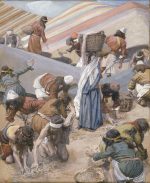Time and Space as Emergent Phenomena — Abstract
The current Torah portion Beshalach tells about the splitting of the Sea of Reeds. As I discussed in my essay, “Collapse and Revelation,” the splitting
The current Torah portion Beshalach tells about the splitting of the Sea of Reeds. As I discussed in my essay, “Collapse and Revelation,” the splitting

The collapse of the wave function is the process of revealing hidden possibilities. Reducing uncertainty reveals information. Until the wave function collapse, the system is

This is the thing which the Lord hath commanded: Gather ye of it every man according to his eating; an omer a head, according to

And the house of Israel called the name thereof manna; and it was like coriander seed, white; and the taste of it was like wafers
Do you like riddles? Here is a riddle – what do these two figures represent in the context of Exodus? No Idea? How about
And the answer is… (drum roll, please) Yes, the first figure represents two doorposts and the lintel marked with blood of Passover sacrifice and circumcisions as
There were some good ideas expressed in the comments. Close, but no cigars. Here are some hints for you folks: 1. These two pictures express
I’ve never done this before on this blog, so this a first — a riddle: What do these two figures represent? Please post your answers in the Comment